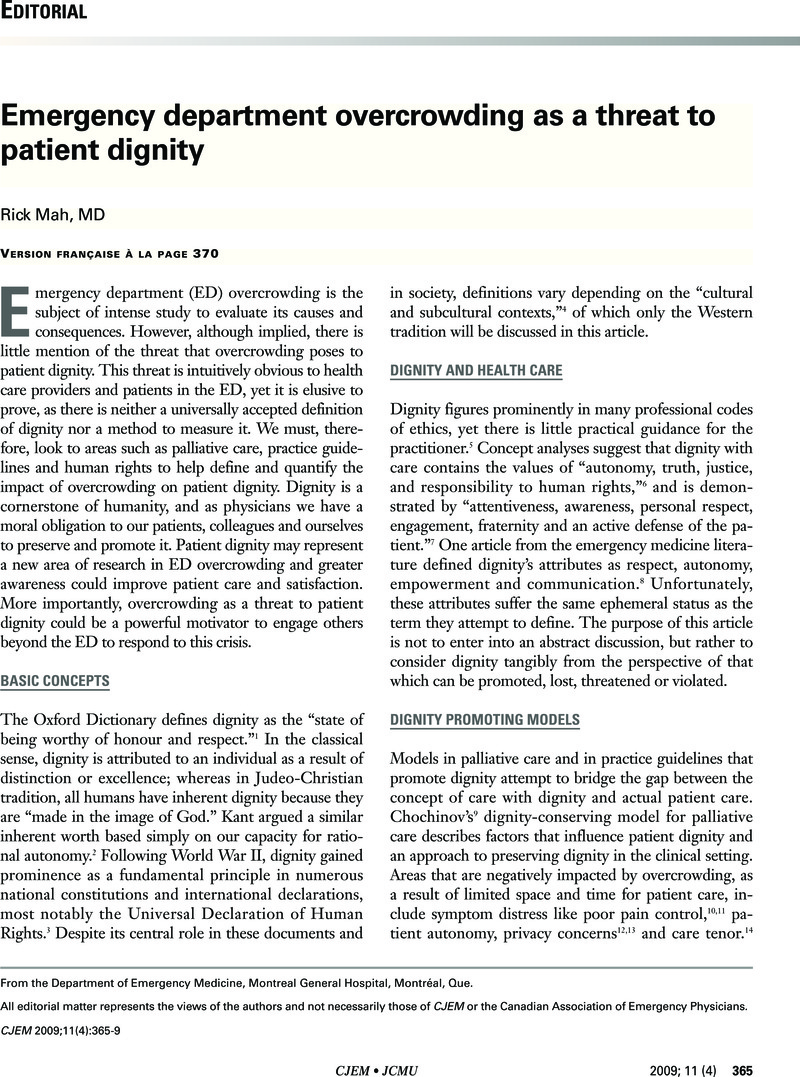Crossref Citations
This article has been cited by the following publications. This list is generated based on data provided by Crossref.
Richards, John R.
Ozery, Gal
Notash, Mark
Sokolove, Peter E.
Derlet, Robert W.
and
Panacek, Edward A.
2011.
Patients Prefer Boarding in Inpatient Hallways: Correlation with the National Emergency Department Overcrowding Score.
Emergency Medicine International,
Vol. 2011,
Issue. ,
p.
1.
Nahid Dehghan Nayeri
Karimi, Rogheyeh
and
Sadeghee, Tabandeh
2011.
Iranian nurses and hospitalized teenagers’ views of dignity.
Nursing Ethics,
Vol. 18,
Issue. 4,
p.
474.
Anantharaman, Venkataraman
and
Seth, Puneet
2014.
Emergency Department Leadership and Management.
p.
257.
McGregor, Margaret J.
Abu-Laban, Riyad B.
Ronald, Lisa A.
McGrail, Kimberlyn M.
Andrusiek, Douglas
Baumbusch, Jennifer
Cox, Michelle B.
Salomons, Kia
Schulzer, Michael
and
Kuramoto, Lisa
2014.
Nursing Home Characteristics Associated with Resident Transfers to Emergency Departments.
Canadian Journal on Aging / La Revue canadienne du vieillissement,
Vol. 33,
Issue. 1,
p.
38.
2014.
Emergency Department Leadership and Management.
p.
163.
Henderson, Katherine
and
Boyle, Adrian
2014.
Exit block in the emergency department: recognition and consequences.
British Journal of Hospital Medicine,
Vol. 75,
Issue. 11,
p.
623.
McGregor, Margaret J.
Murphy, Janice M.
Poss, Jeffrey W.
McGrail, Kimberlyn M.
Kuramoto, Lisa
Huang, Huei-Chung
and
Bryan, Stirling
2015.
24/7 Registered Nurse Staffing Coverage in Saskatchewan Nursing Homes and Acute Hospital Use.
Canadian Journal on Aging / La Revue canadienne du vieillissement,
Vol. 34,
Issue. 4,
p.
492.
Liu, Shan
Milne, Leslie
Yun, Brian
and
Walsh, Kathleen
2015.
The boarding experience from the patient perspective: the wait.
Emergency Medicine Journal,
Vol. 32,
Issue. 11,
p.
854.
Casalino, Enrique
2015.
Bientraitance et qualité de vie - Tome 2.
p.
213.
Verheggen, Elizabeth
2015.
Game Theoretic Analysis of Congestion, Safety and Security.
p.
255.
Ferri, Paola
Muzzalupo, Jennifer
and
Di Lorenzo, Rosaria
2015.
Patients’ perception of dignity in an Italian general hospital: a cross-sectional analysis.
BMC Health Services Research,
Vol. 15,
Issue. 1,
Teitelbaum, Alexander
Lahad, Amnon
Calfon, Nitza
Gun-Usishkin, Monica
Lubin, Gad
and
Tsur, Anat
2016.
Overcrowding in Psychiatric Wards is Associated With Increased Risk of Adverse Incidents.
Medical Care,
Vol. 54,
Issue. 3,
p.
296.
Díaz-Cortés, María del Mar
Granero-Molina, José
Hernández-Padilla, José Manuel
Pérez Rodríguez, Rocío
Correa Casado, Matías
and
Fernández-Sola, Cayetano
2018.
Promoting dignified end-of-life care in the emergency department: A qualitative study.
International Emergency Nursing,
Vol. 37,
Issue. ,
p.
23.
Innes, Grant
Pauls, Merril
Campbell, Samuel G.
and
Atkinson, Paul
2019.
CJEM Debate Series: #HallwayMedicine – Our responsibility to assess patients is not limited to those in beds; emergency physicians must assess patients in the hallway and the waiting room when traditional bed spaces are unavailable.
CJEM,
Vol. 21,
Issue. 5,
p.
580.
Rantala, Andreas
Nordh, Sören
Dvorani, Mergime
and
Forsberg, Anna
2021.
The Meaning of Boarding in a Swedish Accident & Emergency Department: A Qualitative Study on Patients’ Experiences of Awaiting Admission.
Healthcare,
Vol. 9,
Issue. 1,
p.
66.
Umgelter, Andreas
Faust, Markus
Wenske, Slatomir
Umgelter, Katrin
Schmid, Roland M.
and
Walter, Georg
2023.
Do patients referred to emergency departments after being assessed in primary care differ from other ED patients? Retrospective analysis of a random sample from two German metropolitan EDs.
International Journal of Emergency Medicine,
Vol. 16,
Issue. 1,
Walter, Georg
Faust, Markus
Wenske, Slatomir
Raane, Maximilian
Umgelter, Katrin
Schmid, Roland M.
and
Umgelter, Andreas
2024.
Immobilität als Grund der Vorstellung in einer Krankenhausnotaufnahme?.
Notfall + Rettungsmedizin,
Vol. 27,
Issue. 4,
p.
273.
MacIsaac, Meghan
and
Peter, Elizabeth
2025.
Emergency department crowding: An examination of older adults and vulnerability.
Nursing Ethics,
Vol. 32,
Issue. 1,
p.
99.



